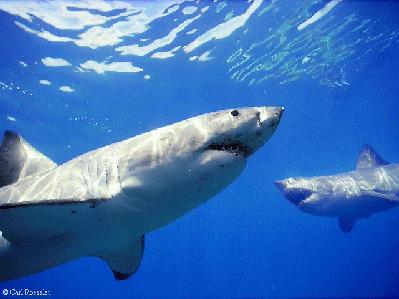CARCHARODON CARCHARIAS

WHITE POINTER
BLUE POINTER
WHITE DEATH
DISTIBUTION
The great white is found in all seas around the world. From the Pacific and Atlantic oceans, to the warm, tropical Mediterranian Sea.
MAXIMUM RECORDED SIZE
2658 lbs. and 21.5 feet long. (Largest reported white shark was 25 ft in length, and almost 4000 lbs)
AVERAGE SIZE
The average size of a mature great white ranges from about 14 to 18 feet in length.
AIR-BORNE ANTICS
As documented by the Discovery Channel's "Air Jaws" the great whites in South Africa have a strange hunting "ritual". These magnificent sharks come flying up from the depths, and completely go airborne as they catch their prey in their jaws. They tend to only do this in a paticular area dubbed as the Ring of Death.
THE LONE HUNTER?
There has been research as of late into a new theory about great white sharks. Evidence is beginning to suggest that this shark may travel in small groups, with a set social structure.
SHARK INTELLIGENCE
Thanks to on-going long term research at the Farrallon Islands and at the Seal Islands we now know the great white is not the mindless, indiscriminate hunter as once thought. They are capable of adaptive learning, applying basic hunting skills, in differant ways to suit their environment and or prey. They also don't "bite first ask questions later". As proven, out of the dozens of shapes presented to them at trolling speed on the ocean's surface, the only shape they responded to with an attack..or even a bite..was the shape of a seal/sea lion cruising along the ocean's surface. Too bad for humans we resemble that basic shape, especially upon a surf or boogie board. Also, when bait fish was put out for the sharks, one in particular found a sucessful way of snatching it away, and getting to eat his meal. (The scientists were not trying to feed them, so they would "snatch" the bait fish away, without the other sharks eating it.) The shark found, if he went down, and snuck straight up under the bait, he could get the fish successfully. This simple act also showed the researchers the white's ability for adaptive learning.
CAGE-LESS DIVING
Mark Marks has started "shedding" the cage, and free diving with great white sharks. He's noted each shark tends to have their own personallity, along with physical characteristics (ie scars etc). There seems to be a set body language between the sharks, as well as a strict social pattern. Although they get close to him, he hasn't been bitten by any of them on any of his numerous dives.
PICTURES